The weather was very warm when we went to bed, but it cooled off to a pleasant temperature overnight. A bright light shined into the camper from the anti-animal perimeter illumination, but with the eye-masks we'd received on our Delta flight, it didn't phase us. I got up before Tom and made use of the very nice ablution block here at Chobe Safari Lodge. The showers had hot water as well as cold, and there were even lights. How extravagant! Also, the toilet stalls had their own paper; you didn't have to BYO. Fancy.
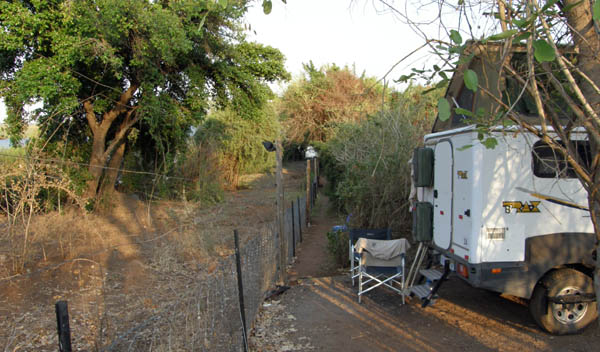
Watch out for the electric fence!
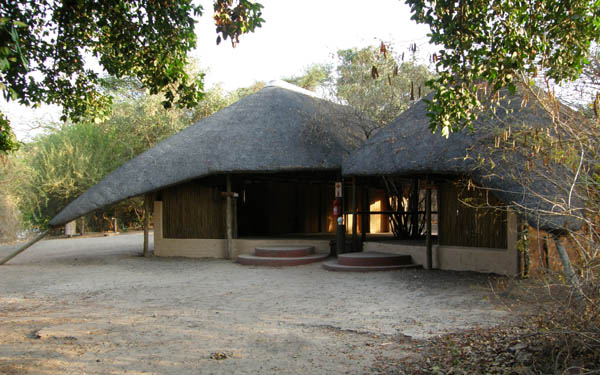
Chobe Safari Lodge ablution block, Kasane, Botswana
By 9:30 we left camp and headed toward the Zambian border at Kazungula, 8km to the east of Kasane. Here Botswana and Zambia share 1.6km of border along the Zambezi River which can be crossed by ferry. Someday they're supposed to build a bridge here, but the two countries have yet to come to an agreement.
On the way to Kazungula, we stopped at Haskins Hardware and finally managed to procure a nut and bolt to secure the back stairs of the camper. The man waiting on us reckoned we needed to buy a spanner (wrench) for our repair, but Tom offered him a few pula if we could just borrow one. He soon agreed and even put the nut and bolt on for us. In total it cost us 26 pula, just over $4, to affix the stairs, which had been annoying us for days. The guy helping us perked right up when he learned we're from the USA. He begged us to take him to America.
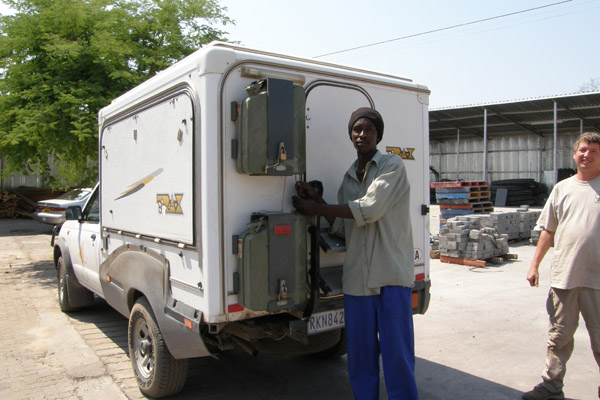
Haskins Hardware helper
Approaching the Kazungula ferry, we came to a line of cargo trucks as far as the eye could see. After a moment, I proposed that we bypass the trucks and see if cars and light passenger trucks like ours might be treated differently, which thankfully turned out to be the case. There are no signs or persons to tell one what to do, and the procedure was a confused muddle on both sides of the border. Tom wheedled our way past the line of trucks in the oncoming traffic lane and on the "shoulder" of the road until we reached Botswana's immigration and customs building, where we parked the 4x4 and went in to be dismissed from the country, again with a form for each of us to fill out and a very important looking stamp for our passports. That was the easy part.
Back in the 4x4, we reached the ferry landing, where the confusion continued. It was unclear where exactly we should wait. There was no official person there to direct us, but one of the foot passengers motioned us to an area near where the ferry lands. The gentleman then came over and began telling us of all the different requirements and payments to be made once we reached the Zambian side of the river. He offered to walk us through the crossing, for a small fee, of course. Thinking it was a scam, we at first declined, but we did offer him a couple of bucks if he could get us on the next ferry. He agreed and then described in more detail the different fees and paperwork on the Zambian side. Having read that getting a vehicle into Zambia could be onerous and confusing, we had a change of heart and decided we wanted all the help he could give us. The man introduced himself as Columbus Malele and showed us his ID. He in fact is a border agent, off duty, and we were glad to have his help.
The crossing of the Zambezi River is only 400 meters on a rather small ferry. One large cargo truck can fit on the ferry each trip, with however many passenger vehicles can squeeze in around it, no more than four, but more reasonably one or two. A ferry comes every 10 to 15 minutes. Columbus did indeed get us on the next ferry, as promised. It was our turn anyway, but that doesn't mean we would have made it on without him!
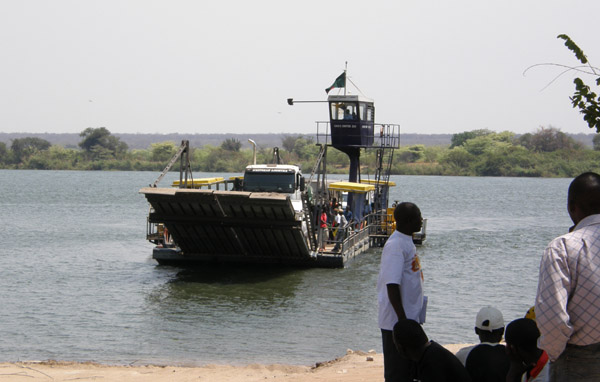
Kazungula Ferry
On the Zambian side of the river, all was a mass of confusion. There is no real parking area, and you just have to abandon your vehicle wherever it will fit while you visit the ill-marked jumble of bureaucratic buildings to get your paperwork in order and pay the various required fees. Columbus and one of his friends guided Tom and me through the maze of administration. Sometimes we were together, and at other times we separated to save time in visiting all the different offices. They got us through in about 30 minutes what would have otherwise taken us most of the day and caused endless frustration.
Here, in as excruciating of detail as I can muster, are the steps necessary to cross from Botswana to Zambia at Kazungula with a vehicle:
- On approaching the border on the Botswana side, bypass the huge line of trucks, park, and proceed to immigration. Fill in the forms supplied. The immigration officer will stamp your passport and give you a gate pass.
- At customs, the driver is to sign a book, and the officer will put an additional stamp on the gate pass.
- With the gate pass, get back in your vehicle and proceed. Give the gate pass to the officer at the gate. He will keep it. You have now officially left Botswana and are in no-man's-land until you fulfill all the requirements on the other side of the border.
- Squeeze your way around more trucks and pedestrians until you reach the river. If there are other cars there waiting to board, get close behind them, but be sure they're actually waiting to board the ferry and not just there waiting to pick up foot passengers. If there are no other cars waiting to board, position your vehicle as closely as possible to the landing, leaving barely enough room for the vehicles on the ferry to exit.
- When the incoming ferry has emptied, drive on board. There won't necessarily be anyone to tell you to proceed, but if they aren't ready for you, presumably, they'll stop you. One car, or possibly two cars side by side, will drive on, then a cargo truck, then possibly one or two more cars. Car passengers must get out and board by foot; only the driver is permitted in the vehicle when loading onto the ferry.
- Once on board, the driver exits the vehicle and signs a book. Then you make the grand voyage of 400 meters across the river before getting back in the vehicle.
- On the Zambia side, any vehicle passengers exit on foot. The driver gets back in the vehicle, drives off, and parks anywhere he can, trying to leave room for others to get by, if possible. This is pretty tricky, and Tom had to leave immigration once and go move the 4x4 to let a cargo truck by.
- Go first to immigration, where you get your passport stamped and pay for a visa. If you are going only as far as Livingstone to see Victoria Falls, it's possible to get your visa fee waived if you make reservations at a lodge in advance. The lodge must arrange the visa waiver for you. I told the immigration officer we were staying at Maramba Lodge in Livingstone and should have a visa waiver, and he checked a "Maramba Lodge" three-ring binder and found the proper documents, so we got in free. Otherwise, as Americans, it would have cost $100 each to enter Zambia. Sheesh.
- Fill out a CIP (Customs Import Permit) at customs, which is in the same little building as immigration, at the next window. Here you will have to show either ownership papers or, in our case, a Letter of Authority from the rental company saying you have permission to use the vehicle and cross into other countries with it. Pay a "consul levy fee" of 10,000 kwacha ($2.50). (I actually paid them 10 pula, which seems like it should have been 15 pula considering the exchange rate, but that's what they asked for when I proposed paying in pula.) I believe this fee was paid at the customs window, but I'm not certain. Get a receipt.
- In a different building pay for the ferry. The pontoon ferry payment office is reasonably well marked. It was $20 for our vehicle, a Nissan hardbody pickup truck. Tom did this while I was paying the carbon tax. Get a receipt.
- In yet another building, at a somewhat hidden window, pay the carbon tax (Thanks, Al Gore) for your vehicle. The fee is by engine volume. I guessed 3 liter (turns out it was only a tiny 2.3 liter, but it's the same price either way). The fee was 150,000 kwacha ($38, but they wanted kwacha). The officer didn't ask for any paperwork to verify the engine size. Get a receipt.
- Also, Zambia requires third-party motor vehicle insurance, conveniently available for purchase right there at the border. A three-month policy is the minimum available, and we paid 225,000 kwacha ($56, but they wanted kwacha). This "office" was in a shipping container with a spray-painted sign on the side. They need the registration number and chassis number off your paperwork from the rental company or your ownership papers. They gave us a one-page certificate of insurance. There were other shipping-container-based third-party insurance offices as well, so maybe you can shop around and get a better deal.
- Columbus had fronted us the kwacha to pay the carbon tax, so we had to pay him back 150,000 kwacha, plus we needed 225,000 kwacha for the insurance. The currency exchange office at the border was closed, perhaps because it was Saturday, so we had to do a black-market exchange right there in the third-party insurance office. In Livingstone they were giving 4,000 kwacha per $1, but here where we were captive customers, we got only 3,500 kwacha per $1, so the 375,000 kwacha cost us $107. At this point I gave Columbus 30 pula, though he'd asked for only 20 pula. Money well spent.
- All that having been done, in a little phone-booth-sized building next to the officer at the exit gate, I signed a book and filled in vehicle information again, then got back in the 4x4 with Tom, who had pulled up to the gate. Columbus's friend spoke to the officer, and he waved us on through without asking us any questions or looking at any of the multitude of certificates, receipts, and various bits of papers we'd collected.
- This is the end of the border crossing. We made it. Yippee! It cost us $130 in total to cross into Zambia with our vehicle. The four fees were the ferry, consul levy fee, carbon tax, and third-party insurance.
From Kazungula to Livingston is about 60km. I say "about" because sometime today our odometer quit working, along with the speedometer and temperature gauge. We stopped at a roadside lay-by to investigate, and Tom traced the problem to a blown fuse under the dash labeled "meters." Now how am I supposed to obsessively keep track of our kilometers without an odometer?
While stopped to check the fuse, I made a couple of sandwiches, and a group of children happened by and stopped a few meters away and watched us eat lunch. When we were finished, I asked if I could take their photo and pointed to my camera, and they started cutting up and doing silly things like kids do. As we pulled away in the 4x4, one of the kids shouted "Run, Forrest Gump, run!"
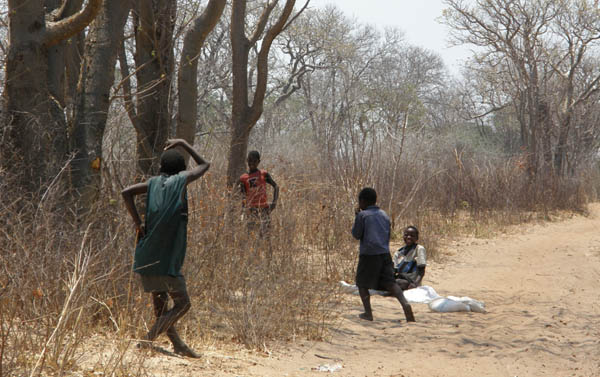
"Run, Forrest Gump, run!"
We drove through two Wildlife Authority checkpoints on our way to Livingstone. The first one was just a wave-through, but the offcer at the second one stopped us a few moments to chat about the weather before letting us pass.
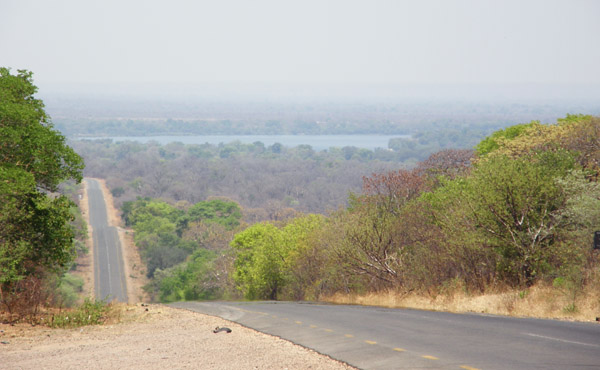
The road to Livingstone, Zambia
At 1:30 p.m. we checked in to Maramba River Lodge, halfway between Livingstone and the Victoria Falls, for two nights in a chalet. The chalet was $105 per night. Camping is much cheaper, naturally, but they don't provide a visa waiver for campers. Since the visa would have cost $100 each, the chalet practically paid for itself! Anyway, we didn't mind a couple of days to spread out after so many nights of staying in the back of our little truck. Maramba let us pay with traveler's checks, which was good since we'd spent so much of our US cash getting into the parks in Botswana because of the ATM problems in Maun. Getting kwacha wasn't necessary since US dollars are so widely accepted in the Vic Falls area, and we'd only be here a couple of days.
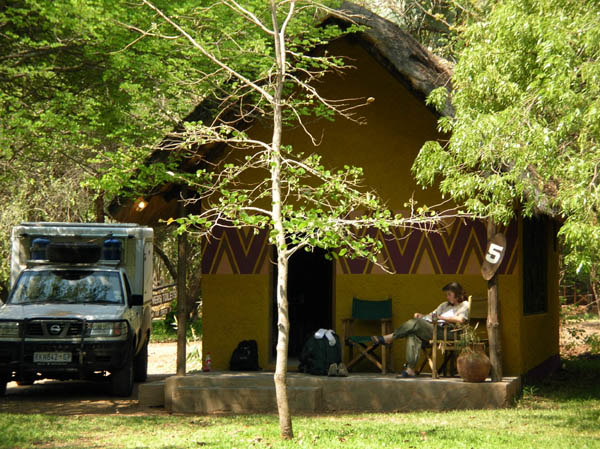
Our excellent chalet, Maramba River Lodge
Maramba is situated in a lovely setting on a side stream that feeds into the Zambezi River. They have a nice bar, pool, and restaurant. There are signs about the property warning "Beware of Crocodiles" and "Beware of Hippos," and they're not kidding.
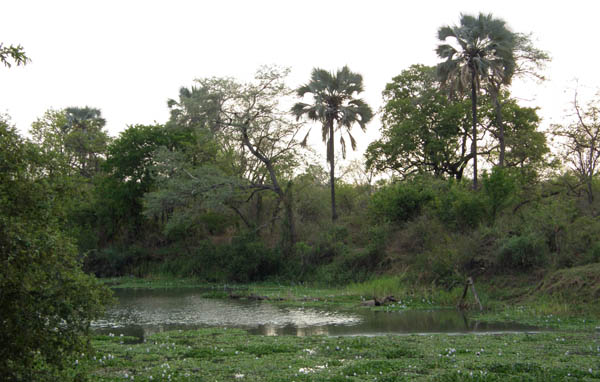
From Maramba River Lodge
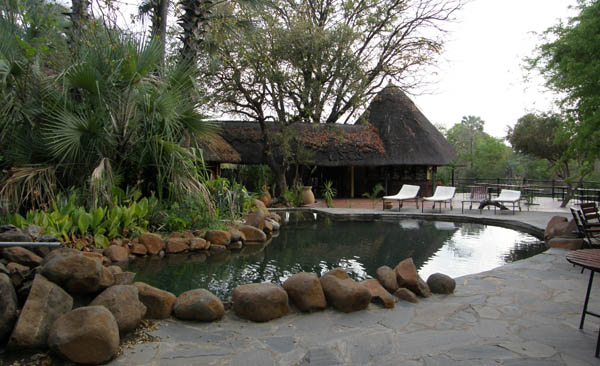
Maramba's pool
We went into Livingstone in search of AAA batteries and a replacement 10-amp fuse. We'd brought lots of batteries from home, but we'd gone through a ton of them for our flashlights since the lights went out on the camper on night 2. The batteries were easy to find, but they were very weak and only lasted a fraction of the time as the ones we were used to. We struck out totally on the fuse. We looked a number of places with no luck, and the one store we were directed to closed early today since it's the weekend. We figured it wasn't that big a deal, since it only controlled the gauges. Maybe we could pick one up on our way out of town Monday.
The town of Livingstone itself seemed unsafe, though we didn't go into the city center, which I've seen described as "charming." I was glad we were staying at Maramba River Lodge, a few kilometers out of town. There were signs at Maramba warning guests not to walk either direction along the road, either toward town or toward the falls, because it's unsafe due to muggings.
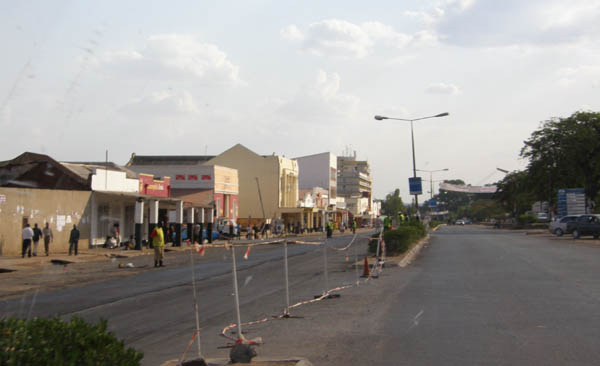
Livingstone, Zambia
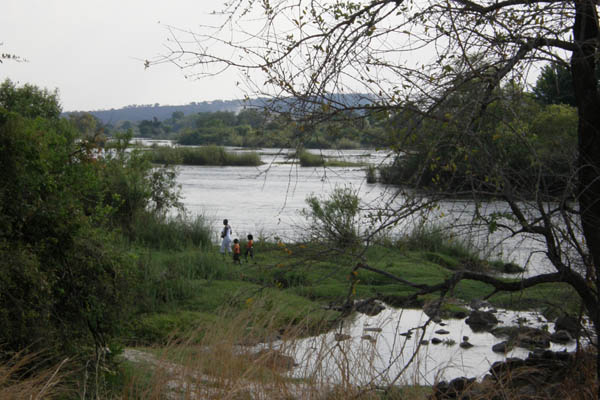
Zambezi River, above the falls
We didn't have time to visit the falls today, but we drove out to where we could see the gorge. The best view we found was the location of the Zambezi Gorge Swing, where one can jump out into 54 meters of nothingness. What a crazy thing to do! Of course, we did the same thing in New Zealand, but that doesn't make it sane. Actually, I would consider doing it again, but this isn't that kind of trip.
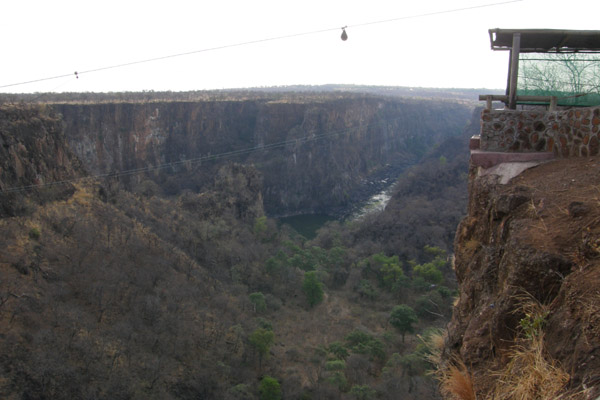
Site of the Zambezi Gorge Swing
At the Super-Spar where I got the batteries, we bought snacks and food for dinner. A guard outside watched our car for $1 while we went in. He was very nice about it, but I didn't feel we really had much choice.
Back at Maramba, I made diced steak with pasta and spaghetti sauce, and we had a nice bottle of South African wine. There was enough food left over for tomorrow night's dinner as well. Later in the evening, a cute little bushbaby was sneaking around our porch trying to thieve our potato chips.
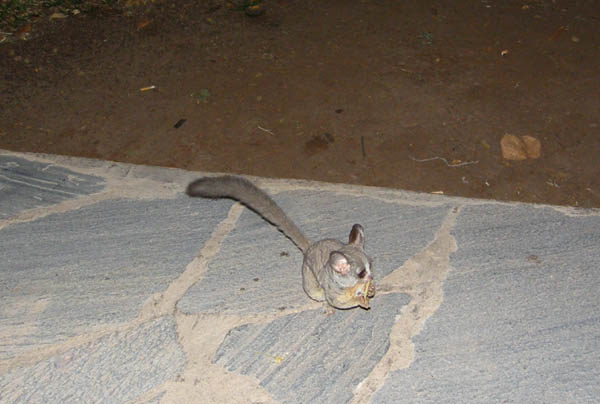
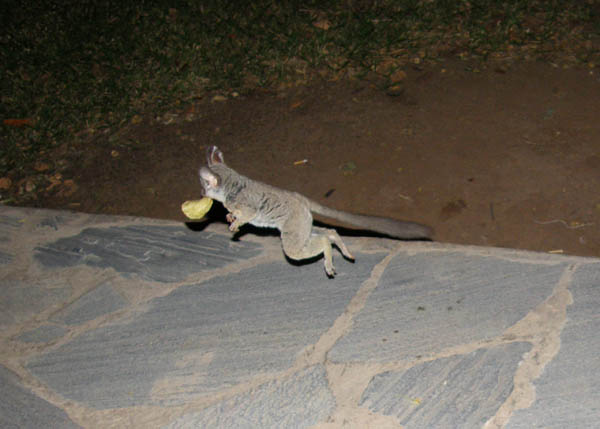
The bushbaby got my chip!
There were loads of mosquitoes in Livingstone, more than we'd seen the rest of the trip combined. We'd been taking Malarone malaria prophylaxis, but with its sensitivity to extremes of temperature, I don't know how well it's going to work. So we sprayed the DEET on thick, lit several mosquito coils, and eventually retreated indoors. A temperature-sensitive medication is a very bad idea for malaria-prone areas, where it's invariably hot outside.
The odometer failed, but I'm calling it 100 kilometers today, around 70km from Kasane to Livingstone, plus 30km extra sightseeing and searching unsuccessfully for a fuse.